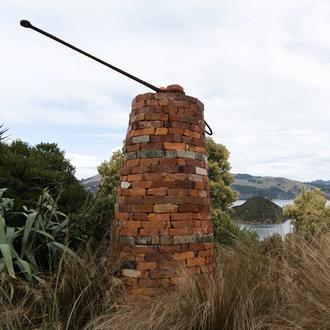Barry Brickell
b. 1935d. 2016
Also known as:
- Ian Barry Brickell
5 Artworks
"I am a generator. I create the amps and volts. The viewer is the lightbulb" ~ Barry Brickell
In his obituary for Barry Brickell, Gregory O’Brien described him thus: "Potter, steam-train enthusiast and trail-blazing conservationist." Hamish Keith noted the "unbroken creative continuum” in Brickell’s life’s work, calling him a "remarkable artist."
Brickell was born in New Plymouth in 1935. An early pottery enthusiast, he built his first kiln at age 7 at the family home in Devonport, Auckland. Surrounded by the estuary of the Waitematā, Barry grew up studying plant, insect and bird life, and the contrastingly muddy and volcanic geology of Tāmaki Makaurau.
While attending the University of Auckland, Brickell also studied pottery, learning techniques from Len Castle and Keith Patterson. He completed a teaching degree, landing as a trainee teacher at Coromandel District High School in 1961. Within six months he resigned, taking up pottery full time. Though teaching was not an enduring career, he maintained an interest in education, for example visiting Elwyn Richardson’s innovative Oruaiti School in Northland throughout the 1960s.
In the Coromandel Barry established the Driving Creek Railway and Pottery Studio, with workshops and kilns where he and other potters worked.
A rail and steam enthusiast, he built a railway on the property, using it to retrieve exotic timber, transporting native seedlings for reforestation and clay for use in his pottery. In his 1979 curriculum vitae, Barry lists his interests - ‘fire, steam, simple and basic machinery, botany (in particular NZ natives), landscape forms, geology, visual arts, civil engineering, railways, colonial and functional architecture and the form of things’.” (MS 2002/22 Barry Brickell Inventory, p3)
In New Zealand Potters: Their works and words (1976) Barry is recorded as helping build oil-burning kilns up and down the country through the 1950s and 1960s. “At Wellington Teachers’ College an up-draught oil-fired kiln was built by Barry Brickell together with the students” Doreen Blumhardt recounts, “experiments were carried out with a drip-feed system and with forced draught. This kiln, using an old vacuum cleaner for a blower and a hub cap for the oil to drip into, served for some years as the first stoneware kiln to be used in the area, and during the seventy-two hazardous firings some fine pots emerged. Finally in 1962 the roof around the chimney burnt and the kiln was demolished.” (p10-11)
Brickell was also a passionate conservationist, who undertook numerous projects in the Coromandel area. O’Brien suggests although the natural world was very significant for Barry, "[t]he human imagination was also central to his world view." Amidst the 27,000 native trees he planted remediating his 1.6-hectare property at Driving Creek, Barry erected "a 7m-tall terracotta sculpture, Maua Uku Ora – a god-like, guardian presence to watch over the regenerating plant and bird life."
Brickell passed away in Coromandel in 2016, aged 80, leaving a legacy of work and influences that can be seen throughout the country. His Driving Creek Railway continues to function and is a site of pilgrimage on the Coromandel for tourists, artists, and conservationists alike.
See also:
- Barry Brickell, wikipedia page
- Driving Creek Railway (official website)
- Barry Brickell, works held by Te Papa Tongarewa ~ Museum of New Zealand
- Gregory O’Brien, Potter shaped the world around him, Dominion Post Weekend, 27 Feb 2016, p7.
- Hamish Keith, Art and life were gloriously the same: Hamish Keith on Barry Brickell, 1935–2016. ArtNews, issue 171, 9 April 2016.
- Barry Brickell, A Barry Brickell Reader: Selected ‘Writings’, Meditations, Outbursts, Decrees and Diversions (Steele Roberts, 2017)
- Barry Brickell, Doggerel Oggereld Dlereggo Brickell: Doggerel, Ditties, Dialogical Dictionals (a Writer's Dictionary) and Drawings (Brett McDowell Gallery, 2012)
- Barry Brickell, His Own Steam: The Work of Barry Brickell (Auckland University Press, 2013)
- Barry Brickell, Plastic Memories: 38 Years of Story-Telling in Clay (Driving Creek Press, 2013)
- Barry Brickell, Rails toward the Sky: The Story of Driving Creek Railway (David Ling Publishing, 2011)
- Barry Brickell, The Story of Driving Creek: Potteries, Railway, Brickworks and Native Forest and Restoration Project : Also a Brief History of Coromandel and a Tribute to the Kauri (Driving Creek Railway & Potteries, 1995)
- Christine Leov-Lealand, Barry Brickell: A Head of Steam, New Zealand Lives : The People Who Shaped the Nation, 3 (Exisle, 1996)
- Julia West, A Collective Memory of Barry Brickell’s Devonport Days. (Depot Press, 2017)
- ‘Artist Barry Brickell dies aged 80,’ Radio New Zealand, 24 January 2016
- Lynton Diggle with David Jordan, ‘Barry Brickell : Potter’ (1970) produced by Geoffrey Scott and Ronals Bowie for the New Zealand Film Unit. Te Rua Mahara of te Kāwanatange Archives New Zealand
- Mary Donald. MS 2002/2 Barry Brickell Inventory. Auckland War Memorial Museum 2011
- Doreen Blumhardt and Brian Brake, New Zealand Potters : Their Work and Words. (A. H. & A. W. Reed : 1976.)

Barry Brickell, ‘Toroa’ detail from ‘The Harbour Ferries’ (1979), pictured at Driving Creek Railways.
Image: Bronwyn Holloway-Smith, Public Art Heritage Aotearoa New Zealand, May 2024

![Untitled [Coromandel Post Office]](/_next/image?url=https%3A%2F%2Fcdn.sanity.io%2Fimages%2Faem3610x%2Fproduction%2Fd174be21e68512b2eff5fa6b157febdb7078c716-1431x1080.jpg%3Frect%3D176%2C0%2C1080%2C1080%26w%3D330%26h%3D330%26fit%3Dclip&w=750&q=75)



